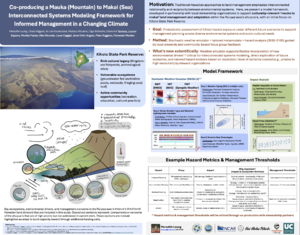2025 CSDMS meeting-128
(if you haven't already)
Log in (or create account for non-CSDMS members)
Forgot username? Search or email:CSDMSweb@colorado.edu
Browse abstracts
Co-producing a Mauka (Mountain) to Makai (Sea) Interconnected Systems Modeling Framework for Informed Management in a Changing Climate
This work is centered on the ahupua‘a (traditional land division) of Puʻuwaʻawaʻa, Hawai‘i, which includes the Puʻuwaʻawaʻa forest reserve, Kīholo Bay state park reserve, and the adjoining ocean. This ahupua‘a supports a rich cultural legacy (traditional fishponds), vulnerable ecosystems (e.g., dryland forests, groundwater-fed anchialine pools, a fringing coral reef), and active recreation and cultural practice opportunities. Quantifying changing environmental conditions across the diverse systems in the Puʻuwaʻawaʻa ahupua‘a requires the integration of models capable of representing atmospheric, oceanic, coastal, and terrestrial systems over management timescales. Here, we develop a modeling framework that couples a stochastic climate emulator (Anderson et al., 2019) that probabilistically simulates future hydro-met-ocean conditions (e.g., waves, water levels, precipitation, temperature) with a nearshore wave propagation model, and a groundwater model. The outputs of the model framework are used in simple hazard exposure analyses to track critical hazard proxies (e.g., number of times fish pond infrastructure is overtopped, number of consecutive storm events, etc.) under a range of climate change scenarios and support decision-making with the entire ahupua‘a system in mind.
The modeling framework and results analysis enhance our understanding of future interconnected ecosystem impacts. They were co-developed with local stewardship organizations through an iterative process (including bi-weekly meetings, in-person gatherings, site visits, etc.) to ensure modeling decisions and hazard proxies directly address community concerns.
- Anderson, D., Rueda, A., Cagigal, L., Antolinez, J. A. A., Mendez, F. J., & Ruggiero, P. (2019). Time-Varying Emulator for Short and Long-Term Analysis of Coastal Flood Hazard Potential. Journal of Geophysical Research: Oceans, 124(12), 9209–9234. https://doi.org/10.1029/2019JC015312.

